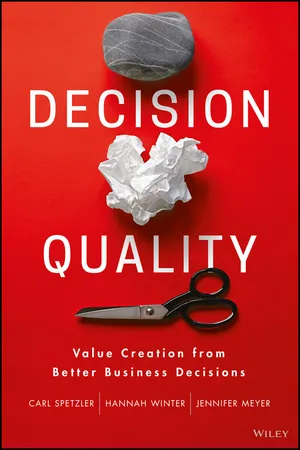
Decision Quality
Value Creation from Better Business Decisions
- English
- ePUB (mobile friendly)
- Available on iOS & Android
Decision Quality
Value Creation from Better Business Decisions
About this book
Add value with every decision using a simple yet powerful framework
Few things are as valuable in business, and in life, as the ability to make good decisions. Can you imagine how much more rewarding your life and your business would be if every decision you made were the best it could be? Decision Quality empowers you to make the best possible choice and get more of what you truly want from every decision.
Dr. Carl Spetzler is a leader in the field of decision science and has worked with organizations across industries to improve their decision-making capabilities. He and his co-authors, all experienced consultants and educators in this field, show you how to frame a problem or opportunity, create a set of attractive alternatives, identify relevant uncertain information, clarify the values that are important in the decision, apply tools of analysis, and develop buy-in among stakeholders. Their straightforward approach is elegantly simple, yet practical and powerful. It can be applied to all types of decisions.
Our business and our personal lives are marked by a stream of decisions. Some are small. Some are large. Some are life-altering or strategic. How well we make those decisions truly matters. This book gives you a framework and thinking tools that will help you to improve the odds of getting more of what you value from every choice. You will learn:
- The six requirements for decision quality, and how to apply them
- The difference between a good decision and a good outcome
- Why a decision can only be as good as the best of the available alternatives
- Methods for making both "significant" and strategic decisions
- The mental traps that undermine decision quality and how to avoid them
- How to deal with uncertainty—a factor in every important choice
- How to judge the quality of a decision at the time you're making it
- How organizations have benefited from building quality into their decisions.
Many people are satisfied with 'good enough' when making important decisions. This book provides a method that will take you and your co-workers beyond 'good enough' to true Decision Quality.
Frequently asked questions
- Essential is ideal for learners and professionals who enjoy exploring a wide range of subjects. Access the Essential Library with 800,000+ trusted titles and best-sellers across business, personal growth, and the humanities. Includes unlimited reading time and Standard Read Aloud voice.
- Complete: Perfect for advanced learners and researchers needing full, unrestricted access. Unlock 1.4M+ books across hundreds of subjects, including academic and specialized titles. The Complete Plan also includes advanced features like Premium Read Aloud and Research Assistant.
Please note we cannot support devices running on iOS 13 and Android 7 or earlier. Learn more about using the app.
Information
Part I
The Decision Quality Framework
1
The Power of Decisions
Life is a sum of all your choices.—Albert Camus
| Decision maker: | Are you telling me that I am not already making good decisions? |
| Decision advisor: | Well, yes. If you are like other human beings, you believe that you are making good decisions when you are far from the making the best decisions possible. |
| Decision maker: | Prove it! |
Decision Quality: A Framework for Better Decisions
Decision Skills Can Be Learned
Decisions versus Outcomes
Table of contents
- Cover
- Title Page
- Copyright
- Dedication
- Acknowledgments
- Preface
- Part I: The Decision Quality Framework
- Part II: The Six Requirements for DQ
- Part III: How to Achieve DQ
- Part IV: The Journey to DQ
- References
- About the Authors
- Index
- End User License Agreement